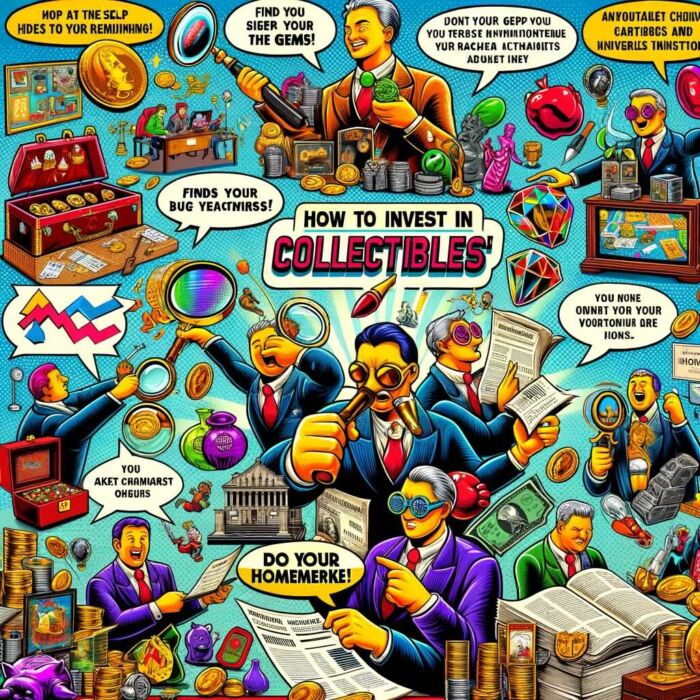Hey there, fellow investors! Are you tired of the same old boring stocks and bonds in your portfolio? Looking to spice things up and add some pizzazz to your investments? Well, have you considered collectibles?
That’s right, collectibles can be a fun and unique alternative investment option that can potentially add value to your portfolio. In this article, we’ll explore the world of collectibles as an investment and cover everything you need to know to get started.

Why diversify with alternative investments:
Before we dive into the exciting world of collectibles, let’s first talk about why it’s important to diversify your portfolio with alternative investments. While traditional investments like stocks and bonds can be stable and reliable, they can also be subject to market fluctuations and economic conditions.
By diversifying your portfolio with alternative investments like collectibles, you can potentially mitigate some of that risk and add a unique element to your investment strategy. Plus, alternative investments often have low correlation with traditional investments, which can help further diversify your portfolio and potentially increase your returns.
What are collectibles as an investment:
So, what exactly are collectibles when it comes to investing? Collectibles are essentially any item that is valued for its rarity, uniqueness, historical significance, or aesthetic appeal. This can include things like artwork, rare books, stamps, coins, vintage cars, and more.
Collectibles can be a bit different from other types of alternative investments, like real estate or commodities, because they are often more subjective in value. The value of a collectible can depend on things like market demand, condition, rarity, and provenance. However, for those who are passionate about a particular type of collectible, the potential for appreciation can be significant.
By the end of this article, you’ll have a solid understanding of what collectibles are as an investment, and whether they may be a good fit for your portfolio. So, buckle up and let’s dive into the world of collectibles!

Potential Benefits Of Investing In Collectibles
Investing in collectibles is a unique way to diversify your investment portfolio and potentially reap some great rewards. While traditional investments like stocks and bonds may offer more stability, collectibles can provide a range of benefits that are difficult to find elsewhere. Here are some of the benefits of investing in collectibles:

A. Potential for long-term growth and income: Collectibles, such as rare coins, stamps, or art pieces, often appreciate in value over time. While there may be fluctuations in the short term, historical data shows that many collectibles have steadily increased in value over the years. If you have a discerning eye and can identify pieces that are likely to appreciate in value, then you may be able to earn a significant return on your investment.
B. Low correlation with other asset classes: Collectibles tend to have low correlation with traditional asset classes, such as stocks and bonds. This means that their value doesn’t fluctuate in the same way that traditional assets do. This makes collectibles an attractive option for investors who are looking to reduce their overall portfolio risk.
C. Enjoyment and hobby aspects: Unlike traditional investments, collectibles can provide enjoyment and entertainment in addition to potential financial gain. Collectors often develop a deep appreciation for their chosen items, whether it be a rare piece of jewelry or a vintage comic book. This passion can add an extra layer of enjoyment to the investment experience.
D. Potential for tax benefits: Collectibles may offer certain tax benefits, depending on the country and the specific collectible. For example, in the United States, certain collectibles are considered “collectibles” and may be subject to a lower capital gains tax rate. Additionally, some countries offer tax breaks for donating collectibles to charitable organizations. As always, when it comes to tax issues, you’ll want to do your own due diligence and check the latest regulations and rules.
source: Reserved Investments on YouTube

Risks & Challenges Of Investing In Collectibles
Investing in collectibles can provide a unique and potentially rewarding investment experience. However, it’s important to do your research and be prepared for the risks and challenges that come with investing in this alternative asset class.
Investing in collectibles can be a lucrative way to diversify your investment portfolio, but it’s important to consider the risks and challenges that come with it. Here are some potential drawbacks to keep in mind:
A. High upfront costs: Collectibles often require a significant investment upfront, whether it’s a rare piece of art, a vintage car, or a rare coin. It can be difficult to find and purchase high-quality collectibles, and the cost of entry can be prohibitively high for some investors.
B. Lack of liquidity: Collectibles are generally not as easy to buy and sell as stocks or bonds, and there is often a limited market for them. This can make it challenging to cash out your investment when you need to, and you may need to hold onto your collectibles for longer periods of time to see a return.
C. Risk of fraud and counterfeiting: The collectibles market is rife with fraudulent activity, and it can be difficult to verify the authenticity and value of certain items. This is especially true for items that are highly sought after, as there may be a higher incentive for fraudsters to create counterfeit versions.
D. Dependence on external factors such as market trends and popularity: The value of collectibles can be highly dependent on market trends and the popularity of certain items. For example, if a particular artist or style falls out of favor, the value of related collectibles may drop significantly. It can be difficult to predict which items will be popular in the future, making it challenging to make informed investment decisions.
Moreover, it’s important to approach collectibles as a long-term investment and to thoroughly research and verify the authenticity and value of any items before investing. It’s also important to diversify your investments and not rely solely on collectibles as a source of income.

How To Invest In Collectibles
Investing in collectibles can be a unique and exciting way to diversify your portfolio. However, it’s important to carefully consider the different investment options and factors before jumping in. Here are some ways to invest in collectibles:

A. Direct ownership of collectibles vs. investing in collectible funds or portfolios:
One way to invest in collectibles is to directly purchase and own them. This can include a wide range of items such as art, rare books, coins, stamps, and sports memorabilia. Another option is to invest in collectible funds or portfolios managed by professionals, which can provide access to a wider range of items and potentially diversify risk.
B. Factors to consider when selecting collectible investments, such as rarity, condition, and provenance:
When investing in collectibles, it’s important to consider the rarity, condition, and provenance of the item. Rarity can greatly impact the value of a collectible, as well as its potential for appreciation. Condition is also important, as even small imperfections can greatly affect the value of an item. Provenance, or the item’s ownership history, can also impact its value and authenticity.
C. Storing and managing collectible investments:
Proper storage and management of collectibles is crucial for maintaining their value and condition. Depending on the type of collectible, this can include measures such as climate-controlled storage, professional handling, and regular inspections. It’s also important to have insurance coverage to protect against damage or loss.
Overall, investing in collectibles can offer unique benefits and challenges. It’s important to carefully consider your goals, investment options, and potential risks before making any investment decisions. Consulting with a financial advisor who specializes in alternative investments can also provide valuable guidance.
source: Patrick Desjardins on YouTube

Potential Performance Of Collectible Investments
Investing in collectibles has been gaining popularity as an alternative investment strategy. It is known to offer potential long-term growth and income, low correlation with other asset classes, and the enjoyment of collecting items that have sentimental or historical value. However, investing in collectibles also poses risks and challenges such as high upfront costs, lack of liquidity, the risk of fraud and counterfeiting, and dependence on external factors such as market trends and popularity.
It is also worth noting that the collectibles market, like any other market, is subject to fluctuations and trends. Some categories of collectibles may experience a sudden surge in demand, driving up prices in a short period, while others may experience a drop in value due to changing tastes or market conditions. Therefore, it is crucial to consider historical performance as well as potential future outlook before investing in collectibles.
Investing in collectibles can offer a unique and enjoyable investment opportunity with the potential for long-term growth and income. However, it also comes with risks and challenges that need to be carefully evaluated. When considering investing in collectibles, it is essential to seek advice from a financial advisor and do thorough research on the collectibles market, including the specific category of collectibles you are interested in.
source: HBS Online on YouTube

Other Alternatives To Invest In Aside From Collectibles
When it comes to diversifying a portfolio with alternative investments, collectibles are just one option. Other alternatives exist that may fit an investor’s needs and preferences better.
A. Real estate can offer long-term growth and income potential. Direct ownership of rental properties can provide steady rental income and appreciation over time, while investing in real estate investment trusts (REITs) offers an opportunity to invest in real estate without the hassle of direct property management.
B. Timberland is another alternative investment that has the potential for long-term growth and income. Similar to real estate, direct ownership of timberland allows for harvesting and selling of timber for profit, while investing in timberland funds or REITs offers an opportunity to invest in timberland without the hassle of direct ownership and management.
C. Commodities, such as precious metals, oil, and agricultural products, have been a popular alternative investment for centuries. Commodities have the potential for long-term growth and provide diversification benefits, as they typically have low correlation with traditional asset classes. However, investing in commodities can be complex and requires knowledge of the commodities market.
D. Wine, like collectibles, offers a unique investment opportunity. Investing in fine wine can provide potential for long-term growth and income, and offers enjoyment as a hobby. However, like collectibles, wine investments can be subject to high upfront costs and lack of liquidity.
While collectibles are one alternative investment option, there are many other alternatives that may better fit an investor’s needs and preferences. It’s important to research and carefully consider the benefits and risks of each alternative investment option before investing.
source: David Aaron Carpenter on YouTube
Collectibles as an Alt Investment: 12-Question FAQ
1) What counts as a “collectible” for investing?
Items valued for rarity, cultural/historic significance, provenance, and condition—e.g., fine art, classic cars, watches, coins, stamps, comic books, trading cards, vintage sneakers, rare books, wine/spirits, musical instruments, and movie/rock memorabilia.
2) Why add collectibles to a portfolio?
They can diversify traditional stock/bond mixes due to low correlation, may protect against inflation (finite supply + global demand), and—unique to this category—offer enjoyment/utility value alongside potential appreciation.
3) What are the biggest risks?
Illiquidity, pricing subjectivity, high transaction/storage/insurance costs, forgery/counterfeit risk, fads and taste shifts, condition damage, and concentration risk if you bet on a single niche.
4) How do collectibles make money?
Price appreciation from scarcity + demand, upgrades in grade/condition (after proper conservation/servicing), provenance improvements (e.g., documented celebrity/artist link), and sometimes income (museum loans, image licensing, or wine en primeur flips—specialized).
5) How do I value a collectible?
Triangulate: recent comparable sales (auction/private), third-party grading or expert condition reports, provenance documentation, edition/serial rarity, population reports (how many exist at each grade), and current category momentum.
6) How do I minimize fraud and authenticity risk?
Buy from reputable dealers/major auction houses, require certificates of authenticity and chain-of-custody, use recognized grading services (e.g., PCGS/NGC for coins, PSA/Beckett/CGC for cards/comics), and consider independent expert opinions for high-value pieces.
7) What about storage, care, and insurance?
Use climate-controlled storage where relevant (art, paper, wine), UV protection and archival materials, periodic servicing (e.g., mechanical watches), and scheduled valuables insurance with appraisals; document condition with photos and inventory software.
8) How liquid is this market?
It varies by category and price tier. Blue-chip art/watches/cars often sell faster (through auctions/dealers) than niche items. Expect weeks to months to sell at fair value; quick sales usually require discounts.
9) What are the fees and carrying costs?
Buyer’s premiums/seller’s commissions, authentication/grading, shipping, import/VAT, restoration/conservation, storage, and insurance. These can materially reduce net returns—budget for them up front.
10) How are collectibles taxed?
Rules vary by country and item type. Some jurisdictions treat collectibles with different capital-gains rates or require self-assessment on private sales; donations can have deduction benefits with proper appraisals. Always confirm with a qualified tax pro.
11) How big should my allocation be?
Keep it prudent within an alternatives sleeve—commonly a single-digit share of your total portfolio (e.g., 1–5%, sometimes up to low-teens for experienced collectors). Diversify across categories and avoid leverage.
12) How do I get started—direct or via funds?
Direct ownership offers control and enjoyment but adds work and costs. Platforms/funds/indices (where available) offer exposure and diversification but add fees and may limit curation. Start with a written thesis, buy quality over quantity, and build relationships with trusted specialists.
Collectibles Final Thoughts
Investing in collectibles can be a unique and rewarding experience, but it is important to weigh the benefits against the risks. On the positive side, collectibles have the potential for long-term growth and income, and can provide an enjoyable hobby for the investor. Additionally, investing in collectibles has the potential for tax benefits and can be a low-correlation asset class.

However, there are also risks to consider, including high upfront costs, lack of liquidity, risk of fraud and counterfeiting, and dependence on external factors such as market trends and popularity. It is important for investors to carefully consider these risks and assess whether they are comfortable taking them on.
For those interested in investing in collectibles, it is recommended to consult with a financial advisor before making any decisions. A financial advisor can help guide the investor in selecting the right collectibles to invest in, and can assist with managing and storing the investments. By taking the time to carefully consider the benefits and risks, and seeking guidance from a professional, investors can make informed decisions and potentially reap the rewards of investing in collectibles as part of a diversified portfolio.
Important Information
Comprehensive Investment Disclaimer:
All content provided on this website (including but not limited to portfolio ideas, fund analyses, investment strategies, commentary on market conditions, and discussions regarding leverage) is strictly for educational, informational, and illustrative purposes only. The information does not constitute financial, investment, tax, accounting, or legal advice. Opinions, strategies, and ideas presented herein represent personal perspectives, are based on independent research and publicly available information, and do not necessarily reflect the views or official positions of any third-party organizations, institutions, or affiliates.
Investing in financial markets inherently carries substantial risks, including but not limited to market volatility, economic uncertainties, geopolitical developments, and liquidity risks. You must be fully aware that there is always the potential for partial or total loss of your principal investment. Additionally, the use of leverage or leveraged financial products significantly increases risk exposure by amplifying both potential gains and potential losses, and thus is not appropriate or advisable for all investors. Using leverage may result in losing more than your initial invested capital, incurring margin calls, experiencing substantial interest costs, or suffering severe financial distress.
Past performance indicators, including historical data, backtesting results, and hypothetical scenarios, should never be viewed as guarantees or reliable predictions of future performance. Any examples provided are purely hypothetical and intended only for illustration purposes. Performance benchmarks, such as market indexes mentioned on this site, are theoretical and are not directly investable. While diligent efforts are made to provide accurate and current information, “Picture Perfect Portfolios” does not warrant, represent, or guarantee the accuracy, completeness, or timeliness of any information provided. Errors, inaccuracies, or outdated information may exist.
Users of this website are strongly encouraged to independently verify all information, conduct comprehensive research and due diligence, and engage with qualified financial, investment, tax, or legal professionals before making any investment or financial decisions. The responsibility for making informed investment decisions rests entirely with the individual. “Picture Perfect Portfolios” explicitly disclaims all liability for any direct, indirect, incidental, special, consequential, or other losses or damages incurred, financial or otherwise, arising out of reliance upon, or use of, any content or information presented on this website.
By accessing, reading, and utilizing the content on this website, you expressly acknowledge, understand, accept, and agree to abide by these terms and conditions. Please consult the full and detailed disclaimer available elsewhere on this website for further clarification and additional important disclosures. Read the complete disclaimer here.





